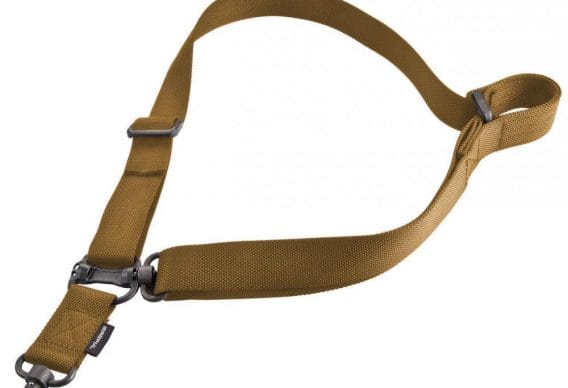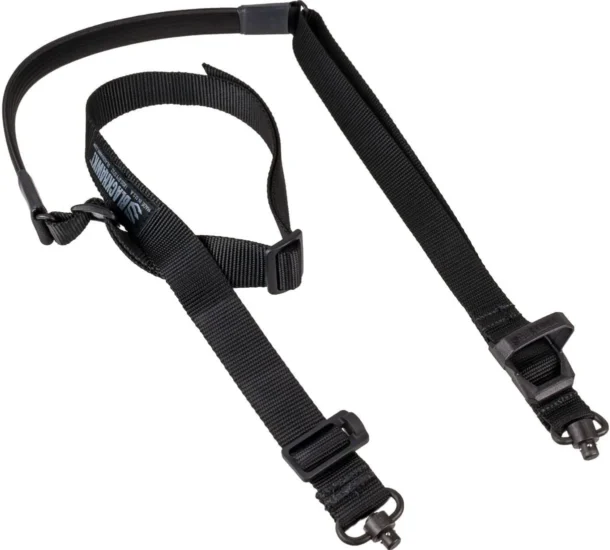Whether you are in the military or a hunter, the best rifle slings offer a variety of benefits including comfort and durability. There is an astounding difference between a sling that simply gets by and one that lasts for years.
Another benefit of the best rifle slings is that they save you money, in that you don’t need to replace them often. They survive rugged use when hiking through the mountains, hunting in the mountains, and in other rough situations.
Different Rifle Slings for Different Purposes
Unfortunately, there are thousands of rifle slings on the market. The fact that different types of rifle slings are designed for different purposes makes one’s choice even more difficult. So what do you do when you need a rifle sling but don’t know where to start? Our comprehensive guide aims at giving you all the information you need to aid your search.
We also have a great rifle caliber guide for those who want to know more about rifles.
Table Of Contents
How to Choose the Best Rifle Slings?
These are the factors you should look for choosing the right rifle sling for your rifles and what your needs are.
The Right Rifle Sling Material
Rifle slings are usually made from either nylon or leather. Many people prefer nylon slings are lighter while others prefer leather slings because it’s a more elastic material.
At the end of the day, the choice of the right material comes down to personal preference. It’s however important to note that leather stretches over the years and is a better choice for someone who loves the traction as well as style that this material offers.
Comfort
The main reason why people invest in a rifle sling is to add to the comfort. It’s important to ensure that your sling has at least 2-3 inches of wide and thick padding. This goes a long way towards reducing stress on the shoulder as well as maintaining balance while on the move.
By so doing, extra padding makes it easier to carry and use your rifle for longer hours before discomfort sets in. Adjustability also helps with comfort as it allows the sling to fit people of various sizes.
Versatility
Some slings are designed to be incredibly versatile and for use with a vast number of rifles. Purchasing such slings makes more financial sense as they are compatible with many rifles. It is best to buy a sling with several slots.
Types of Rifle Slings
Rifle slings are broadly categorized into three i.e. single-point, two-point, and three-point slings. Single-point slings use one connection point to the gun while two-point slings use two connection points to gun.
 Three-point Slings
Three-point Slings
Three-point slings also have two connection points, but have an additional loop that goes around the torso. The three-point sling typically runs over the shooter’s shoulder and across the chest, and is designed to allow the shooter to quickly transition from carrying the weapon to shooting it.
The Ching-sling
The Ching-sling incorporates the principles of two-point slings and hasty slings. It uses three connection points to the gun. The Ching sling is designed to provide stability when shooting from a standing, sitting, kneeling, or prone position.
A Cuff-Sling
A cuff-sling, on the other hand, is designed to get an accurate shot without having to use a bipod. It is a loop-shaped sling that wraps around the shooter’s forearm, providing support and stability by allowing the shooter to use their own body weight to control the rifle. It can also be used effectively for any air rifle.
Carrying Rifle Slings Reviewed
Single-point rifle slings
These slings are a favorite option for many gun enthusiasts simply because they are incredibly comfortable. They wrap around the body and the point attaches to the gun or rear.
| Pros | Cons |
|---|---|
| Makes picking up and dropping guns easy | They provide little shooting support and as such, the aim doesn’t improve much as compared to when you don’t have a sling |
| The gun sits in front of you, point in a safe downward direction | The gun sways a lot, especially when not holding it |
| Great for moments when you need to grab the weapon at a moment’s notice or go hands-free | Users constantly get knocked in their groin or knees |
| Allows for a wide range of movements including transitions caused by barriers | |
| Can also be worn to the side |
Best Single-Point Rifle Sling: Magpul MS4 Dual QD Multi-Mission Sling
What makes the MS4 stand out is the fact that it allows for single-point as well as two-point configurations. It incorporates push-button QD sling swivels on both ends rather than the snap hook design found on other Magpul slings.
The sling swivels are a welcome feature that allows for versatility and use with several gun systems. This sling can be adjusted quickly, making it easy to switch from one rifle to another instantly.
The MS4 has various functions including holding the rifle on the shooter’s back while negotiating obstacles as well as retaining the gun on the body when transitioning to a secondary weapon. It can also be used as a shooting aid when you need an unsupported firing position.
This sling comes with a tri-glide buckle that helps with adjusting the length. The Receiver Box and QD Sling Swivels are both made of steel and coated with black oxide. We love the fairly substantial, 1.25” thick nylon webbing as it improves strength and reduces the risk of fraying.
Two-point Rifle Slings
Otherwise known as carrying straps, two-point slings connect to the front and rear of a firearm. They are quite popular and often used for carrying weapons over the shoulder, particularly during long hunting expeditions.
| Pros | Cons |
|---|---|
| They come in handy for carrying weapons and improving the aim | A two-point sling makes it difficult to retrieve the weapon quickly, especially when time is of the essence |
| The hasty-sling method of carrying the sling involves looping it around the dominant arm and using the tension to keep the weapon stable. It’s a great way to improve your aim. | It’s not easy to transition from side to side |
| The loop sling is a shooting modification used with the two-point sling. It is achieved by disconnecting the rear of the sling, and sliding the arm through the loop before pulling tightly. This technique allows one to stabilize a long gun, hence a more accurate shot. |
| Product Name | Where to Buy | |
|---|---|---|
 | Viking Tactics VTAC MK-2 | |
 | Vickers Sling by Blue Force Gear |
Best Two-Point Rifle Sling: Viking Tactics VTAC MK-2
This is a wide weapon sling and an upgraded version of the original VTAC MK-1 sling. It comes with the added benefits of tough construction and faster adjustment, both of which come in handy in combat situations.
The sling is constructed using a rugged nylon material, which is preferred by manufacturers for its lightweight nature and resilient performance. Like the MK-1, its rapid configuration features closed-cell foam padding for comfort.
Viking Tactics uses a new rubber pull that is well-textured, allows for easy adjustments, and offers an easy grip. Rather than plastic buckles, the MK-2 has metal hardware for enhanced durability.
Notable Two Point Rifle Sling: Vickers Sling by Blue Force Gear
The Vickers Sling has revolutionized the way military carries automatic weapons. It was designed with the help of Larry Vickers, a former first SFOD-Delta operational member.
The sling incorporates key features that you would expect in a world-class tactical two-point sling. Such include the patented Quick Adjuster, which allows for a quick transition from carrying a weapon to being combat-ready.
It is constructed using 1.25” nylon webbing for durability and stellar performance. The overall length is adjustable, thus allowing for a comfortable fit and accommodating weapons of different sizes.
Three Point Rifle Slings
As previously noted, three-point slings have two points of attachments and an additional loop that goes around the torso.
Best Three Point Rifle Sling: BLACKHAWK Multi Pt. Sling
If you are on the market for something that doesn’t restrict your body movements excessively, the BLACKHAWK Multi Pt. Rifle Sling will prove a worthy investment. It is made with nylon web and features polycarbonate clasps and keepers for durability.
The keepers and clasps are welcome features that hold the weapon in a comfortable position until you need to fire. Another notable feature is that all the stress points are double-stitched for maximum strength and durability.
We love that it is available in a variety of tactical styles for use with different types of guns. With a choice of six positions, you can rest assured that keeping your hands free and bringing the weapon to action is easy.
Like other slings in this guide, the Specter three-points have an adjustable length and don’t have unnecessary fasteners, buckles or straps.
| Pros | Cons |
|---|---|
| It keeps the weapon within easy reach | It tends to get caught on block ejection ports and release mechanisms of rifles |
| Offers more control than single-point slings when moving hands-free | |
| Easy to transition from rifle to sidearm and vice versa without worrying about fumbling between weapons |
Rifle Shooting Slings Reviewed
Slings can be designed to either help you carry your gun or improve your shot. That said, shooting slings are available in two main types i.e. Ching Sling and Cuff Sling.
| Product Name | Where to Buy | |
|---|---|---|
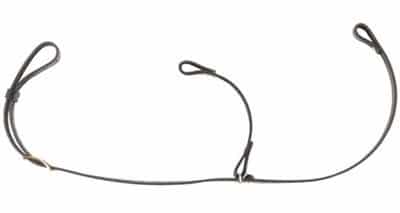 | Andy’s Leather Ching Sling | |
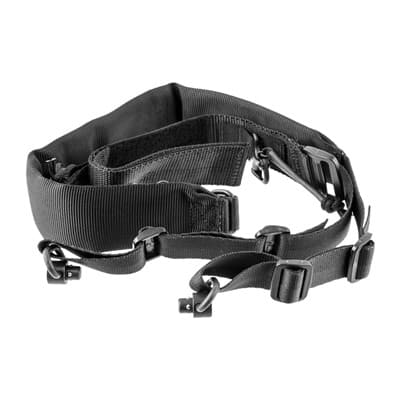 | VIKING TACTICS – V-TAC PADDED SLING WITH CUFF ASSEMBLY |
Ching Rifle Sling
This type of sling is a special two-point sling with an additional strap that attaches to the center stud of a gun. You can think of it a two-point sling that was specially designed for executing the hasty-sling shooting method.
The small strap can be slid up and out of the way when using this sling to carry a rifle. All you need to do when shooting time comes is loop the dominant arm through the loop created by the first and center studs. This allows for a steadier aim.
Best Leather Ching Sling: Andy’s Leather Ching Sling
Andy’s Leathers offered two Ching Slings i.e. Biothane and Scout Rifle Ching Slings. Both of these are designed with advanced features to ensure a great shooting experience. The former is a synthetic version of the Ching Sling and features black Cerakote hardware.
The swivels come pre-installed and the sling is available in two widths i.e. 1” and 1.25”. You have the freedom to choose between a machine screw for a Ruger Scout synthetic stock and a wood screw for wood or laminated stocks.
The Scout Rifle Ching Sling, on the other hand, is a 3-point sling whose design is based Eric Ching’s original work. It is also available in 1” and 1.25” widths, in three leather colors as well as three colors. Our only concern is that the swivels for this sling are sold separately.
Cuff Slings
Cuff slings are a favorite variation among sharpshooters as they allow for a steady, accurate shot even without a bipod. They are a great way to improve your shot and are easier to set up compared to loop sling methods including the USGI sling.
Best Cuff Sling: VIKING TACTICS – V-TAC PADDED SLING WITH CUFF ASSEMBLY
The Viking Tactics Rifle Sling’s padded shoulder strap is wide and adjustable and spreads the weight of the rifle comfortably across your shoulder. The quick-release buckle makes it easy to get the sling off and on quickly. The cuff assembly that comes with it is a nice touch and adds extra stability and control when aiming.
I also like the multiple mounting options that this sling provides. It’s definitely a great choice for anyone looking for a well-made, comfortable, and versatile rifle cuff sling.
Best Rifle Slings for Different Purposes
These are a few of our best rifle slings for various purposes, like hunting and specifically a tactical rifle sling.
| Product Name | Where to Buy | |
|---|---|---|
| Butler Creek Comfort Stretch | ||
 | Blue Force Gear Vickers Sling |
Best Hunting Rifle Sling – Butler Creek Comfort Stretch
Comfort slings by Butler Creek are built with a stretchable construction and soft padding that soak up the bounce you get with traditional slings. It features a 1-inch wide nylon webbing that is padded with neoprene foam to make it comfortable on the shoulder.
It has a quick-release buckle that makes it easy to attach and detach from your rifle. It also has a non-slip backing to keep it in place. It has swivels and studs that allow for quick and easy transitions from one shoulder to the other.
Best Tactical Rifle Sling – Blue Force Gear Vickers Sling
The Blue Force Gear Vickers Sling is a great all-purpose tactical sling designed by renowned firearms instructor Larry Vickers. It is a two-point sling that features quick adjustment and can be used on a variety of firearms.
| Pros | Cons |
|---|---|
| Made from high-quality materials that are both strong and durable. It is constructed out of heavy-duty webbing, with a military-grade plastic buckle and steel locking hardware. | Can be difficult to adjust for those with smaller hands. |
| Can be quickly adjusted for length, making it easy to switch between different shooting positions. | The sling does not feature a quick release, making it difficult to quickly transition from one position to another. |
| The Vickers Rifle Sling is designed to be low profile and can be easily concealed under clothing. | It can be a bit pricey for some budgets. |
| Features a built-in loop for attaching a weapon light or other accessories. |
Additional Rifle Sling Hardware that You May Need
It’s important to understand that a sling may not always be enough. You may need to invest in additional hardware to help you attach to the rifle.
The Troy Rail Mount is a handy tool that you go into the rail. You will need it for the forward attachment if your preferred rifle sling doesn’t have a swing swivel on the front sight block.
If you need to do a quick disconnect, consider investing in the Magpul RSA QD for the rails. You can also go with the BCM QD End Plate for the rear. It is a great option for single-point slings.
Maybe you are interested in scoping your rifle and trying to find the right scope. Check out our Rifle scopes guide for in-depth info.
Best Rifle Slings – Conclusion
Before buying a rifle sling for specific purposes, consider practicing how to use one. Keep in mind that it takes time to get used to a new sling so be patient. When using a leather strap, mark the most comfortable notch to avoid repeatedly looking for the perfect adjustment point.
Whether you are using a loop or cuff sling, ensure that you don’t over-tighten it as this will constrict your movements. Remember that your choice of a gun sling can make the difference between the ability or inability to switch firearms quickly.
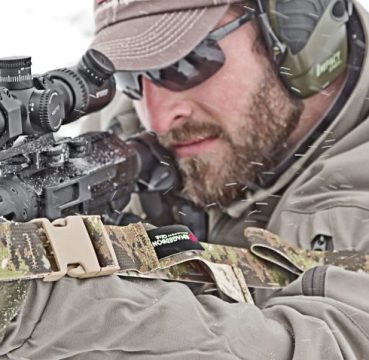


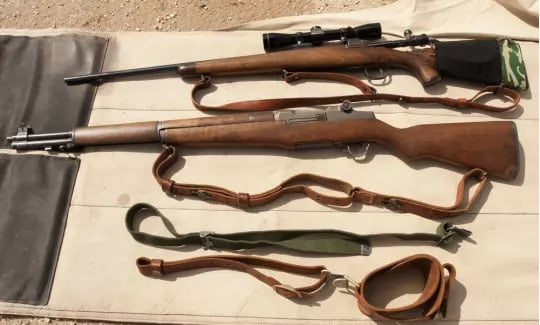 Three-point Slings
Three-point Slings